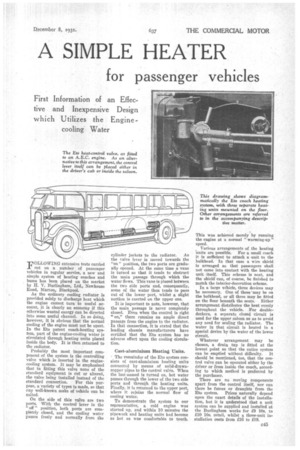A SIMPLE HEATER
Page 67

If you've noticed an error in this article please click here to report it so we can fix it.
for passenger vehicles
First Information of an Effective and Inexpensive Design which Utilizes the Enginecooling Water
VOLLOWING extensive tests carried out on a number of passenger vehicles in regular service, a new and simple system of heating coaches and buses has been placed on the market by EL V. Burlingham, Ltd., Newhouse Road, Marton Blackpool. As the ordinary cooling radiator is provided solely to discharge heat which the engine cannot turn to useful account, it is clearly an economy if this otherwise wasted energy can be directed into some useful channel. In so doing, however, it is obvious that the normal cooling of the engine must not be upset. In the Eto patent coach-heating system, part of the engine-cooling water is circulated through heating units placed inside the body. It is then returned to the radiator.
Probably the most important component of the system is the controlling valve which is inserted in the enginecooling system. It may be emphasized that in fitting this valve none of the standard equipment is cut or altered, the valve being installed instead of the
standard connection. For this purpose, a variety of types is made, so that any well-known make of vehicle can be suited.
On the side of this valve are two ports. With the control lever in the " off " position, both ports are completely closed, and the cooling water passes freely and normally from the cylinder jackets to the radiator. As
the valve lever is moved towards the "on" position, the two ports are gradually opened. At the same time a vane is turned so that it tends to obstruct the main passage through which the water flows. This vane is placed between the two side ports and, consequently, some of the water then tends to pass out of the lower port, whilst a slight suction is exerted on the upper one.
It is important to note, however, that the main passage is never completely closed. Even when the control is right "on," there remains an ample direct passage from the engine to the radiator. In that connection, it is stated that the leading chassis manufacturers have certified that the Eto system has no adverse effect upon the cooling circulation.
Cast-aluminium Heating Units.
• The remainder of the Eto system consists of cast-aluminium heating units connected by means of solid-drawncopper pipes to the control valve. When the last-named is turned on, hot water passes through the lower of the two side ports and through. the heating units. Finally, it is returned to the upper port, where it rejoins the normal flow of cooling water.
To demonstrate the system to our representative, a cold engine was started up, and within 10 minutes the pipework and heating units had become as hot as was comfortable to touch.
This was achieved merely by running the engine at a normal " warming-up " speed.
Various arrangements of the heating -units are possible. For a small coach it is sufficient to attach a unit to the bulkhead. In that case a wire shield is arranged so that passengers shall not come into contact with the heating unit itself, This scheme is neat, and the shield' can, of course, be finished to match the interior-decoration scheme.
In a large vehicle, three devices may be necessary. One of these 'may be on the bulkhead, or all three may be fitted on the floor beneath the seats. Either arrangement distributes the heat evenly throughout the vehicle. For doubledeckers, a separate closed circuit is used for the upper saloon so as to avoid any need for sealing the radiator. The water in that circuit is heated in a special device by the water of the lower circuit.
Whatever arrangement may be chosen, a drain tap is .fitted at the lowest point so that the entire system can be emptied without difficulty. It should be mentioned, too, that the control valve can be operated either by the driver or from inside the coach, according to which method is preferred by the purchaser.
There are no moving components apart from the control itself, nor can there be fumes or draughts from the Eto system. Prices naturally depend upon the exact details of the installation, but it is understood that a unit system can be supplied and installed at the Burlingham works for £9 10s. to £10 10s. retail, whilst a three-unit installation costs from £16 to £19.














































































































